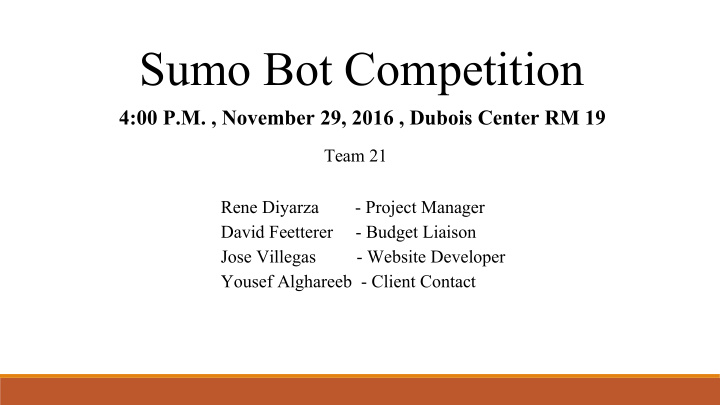



Sumo Bot Competition 4:00 P.M. , November 29, 2016 , Dubois Center RM 19 Team 21 Rene Diyarza - Project Manager David Feetterer - Budget Liaison Jose Villegas - Website Developer Yousef Alghareeb - Client Contact
Project Description Four different types of robots must be design for four different types of competition. Two robots compete in a head-to-head match following the basic system of traditional human sumo matches. NAU is our primary sponsor financially and managerially Showcase our skills obtained from the undergraduate program at NAU 1 JV
Design description(Autonomous) - Robot starts moving forward. - Line or opponent Detectors receive signal. - Signals will be sent to the controller. - Controller will send signal to motor driver to start rotating motors. Figure 1: Autonomous Robot 2 YA
Design requirements(Autonomous) Table 1 : Autonomous CR - 4 motors provide more pushing force. - Total weight is less 3 kg. - Length and width are less than 20 cm. - The robot is able to act independently through matches. 3 YA
Design description (R/C) Highlighted Specifications ● Independent 4-wheel drive ● Adjustable bumpers focusing on impact ● Design leans forward for improved balance ● Controlled by R/C remote ● Rubber wheels for traction In operation ● Controlled by user with R/C remote 4 JV
Design requirements (R/C) ● Mass ≤ 3000 grams ● Length & width ≤ 20 cm ● Height: unlimited ● Must be remoted controlled ● R/C remoted cannot be 75 Mhz ● Must be digitally-mated paired 5 JV
Design description (Nano) Structural/Drive ● PLA 3D printed uni-body ● Wedged front scoop ● Compartmentalized interior ● Independent two wheel drive with 4:1 gear ratio ● Front supported by 3 spherical casters. ● Optimized center of mass. Operational Algorithm ● Spiral pattern with conditional decreasing radii. ● Tactile switches on all faces as failsafe. 6 DF
Design requirements (Nano) ● M < 25g ● Total volume < 15.625 cm^3 ● Generate maximum thrust ● Autonomous navigation ● Actively pursue opponent ● Resist failure (mass of broken components cannot exceed 5g) 7 DF
Design description (Bartending) Structural/Components ● 3D printed components ● Bottom base capable to hold 4 bottles ● Sleek Design ● Feature 4 peristaltic pumps ● Tubing potential FDA approved In Operation ● “Squeezes” liquid ● Provides at least 4 different drink combination 8 RD
Design requirements (Bartending) - Flow Rate < 0.055 m^3/s - Volume < 0.0956 m^3 - Weight < 2.5 kg - Goals of the team - No restrictions on the system 9 RD
Schedule 10 RD
Budget Robot Available Balance Anticipated Expenses Resulting Balance 3kg Autonomous $ 375 $ 170 $ 205 3kg R/C $ 375 $ 120 $ 255 Nano Autonomous $ 375 $ 200 $ 175 Bartending $ 375 $ 150 $ 225 Total $ 1500 $ 640 $ 860 11 DF
Questions? 12
Recommend
More recommend